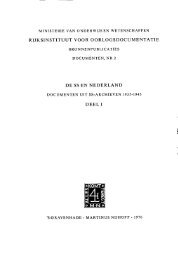De razzia van Rotterdam. 10-11 november 1944 - KNAW
De razzia van Rotterdam. 10-11 november 1944 - KNAW
De razzia van Rotterdam. 10-11 november 1944 - KNAW
Create successful ePaper yourself
Turn your PDF publications into a flip-book with our unique Google optimized e-Paper software.
SUMMARY 2 6 3<br />
conditions in western Holland during the last winter of the occupation. The question<br />
whether conditions in <strong>Rotterdam</strong> had been made more difficult or less so as a result<br />
of the arrest of so many men could only be answered by comparative research, for<br />
example with conditions in Amsterdam, or in some other town where no large-scale<br />
<strong>razzia</strong> had been held. This point has not been investigated in detail. For this reason<br />
conditions in <strong>Rotterdam</strong> after the <strong>razzia</strong> have only been described in as far as the<br />
social and psychological situation immediately after the <strong>razzia</strong> was concerned.<br />
Attention was also paid to the ways in which the families left behind were assisted<br />
and to the attempts made to bring men back to <strong>Rotterdam</strong>.<br />
Finally the author had to investigate how the men of <strong>Rotterdam</strong> were used by<br />
the Germans in their war economy. They had been transported to so many different<br />
places that a detailed description of their experiences in Germany and the eastern<br />
part of Holland would have entailed a special program of research. On the basis of<br />
data available he confined himself to a general survey in Chapter XI.<br />
In a report written after the <strong>razzia</strong> by the German official Liese, Generalbevoll-<br />
machtigte für den totalen Arbeitseinsatz (General deputy for total War labour Economy),<br />
it was stated that about 54.000 men were taken prisoner as a result of the<br />
<strong>razzia</strong>. It was not known whether this figure was reliable. After the completion of<br />
the research program all data which might throw light on the number of people<br />
deported, were made available tot the Mathematisch Centrum (Centre for Mathema-<br />
tical Research), Amsterdam. The number of deportees was estimated by this Centre<br />
at 52.000.<br />
SOURCES<br />
When Mr. Sijes started his researches only very few data appeared to be available<br />
at the Netherlands State Institute for War Documentation. In order to obtain a<br />
preliminary picture, it was decided with the assistance of the <strong>Rotterdam</strong> press, to ask<br />
the townspeople of <strong>Rotterdam</strong> to describe by letter their experiences at the time of the<br />
<strong>razzia</strong> and afterwards. Ninety letters, five diaries, and five extended reports were<br />
received. This material although valuable was clearly not sufficiënt. In order to<br />
supplement it contact was made with both the authors of the letters, diaries and<br />
reports and with other people. Considerable use was made of personal interviews.<br />
This was the only method by which sufficiënt material could be collected to form a<br />
general picture. There were, however, other considerations which decided the author<br />
to make principal use of interviews.<br />
The letters and diaries had shown that in general the deportees had paid little<br />
attention to the behaviour of other people during the <strong>razzia</strong> or to the question as to<br />
what extent they had been influenced by it.<br />
Letters could not be expected to contain data of a social-psychological nature.<br />
This lack could only be remedied by means of interviews. Interviews were arranged<br />
with people from alle classes of the population who had been or who had not been






